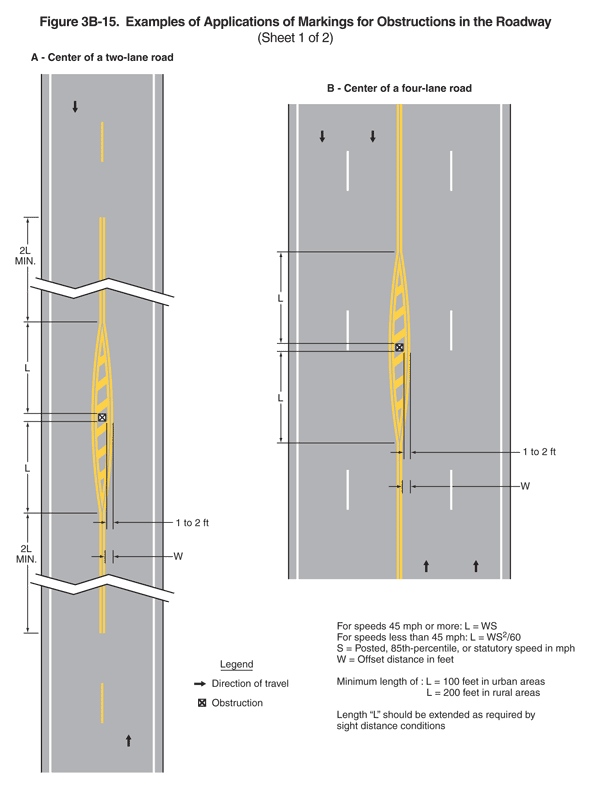2009 Edition Part 3 Figure 3B-15. Examples of Applications of Markings for Obstructions in the Roadway (Sheet 1 of 2)

Figure 3B-15. Examples of Applications of Markings for Obstructions in the Roadway (Sheet 1 of 2)
This figure illustrates three examples of markings for obstructions in the roadway. The figure is composed of two sheets.
The figure shows three vertical roadways: examples A, B, and C. Each example shows a black "x" inscribed in a white square, denoting an obstruction, in the middle of a parallelogram-shaped island formed by tapered solid lines on each side of the obstruction.
Sheet 1 of the figure shows two vertical highways, examples A and B. Notes state "For speeds 45 mph or more, L = WS. For speeds less than 45 mph, L = WS2/60. S = posted, 85th percentile, or statutory speed in mph. W = offset distance in feet. Minimum length of L = 100 feet in urban areas and 200 feet in rural areas. Length 'L' should be extended as required by sight distance conditions."
- A legend shows a black arrow indicating the direction of travel in the lanes and a black "x" inscribed in a square denoting an obstruction.
- The first example is labeled "A – Center of a two-lane road." It shows an obstruction in an island formed by diagonal solid yellow lines in the center of a segment of a two-lane road. Arrows show that the direction of travel is one lane in each direction. Starting from the bottom of the illustration, a solid double yellow line separates the opposing lanes and then continues as it approaches the obstruction. Then it separates into two tapering solid double yellow lines, one solid double yellow line on each side of the obstruction. Beyond the obstruction, the two solid double yellow lines taper back to merge into one solid double yellow line at the center of the roadway. The one solid double yellow line then continues along the center of the road as it approaches the top of the illustration. Several dimensions are shown on the figure. "W" is shown as the offset from the normal center of the roadway to the outside edge of the solid double yellow line immediately opposite the obstruction. That outside edge of the solid double yellow line is shown as 1 to 2 ft from the edge of the obstruction. "L" is shown as the longitudinal distance along the roadway for the taper of the solid double yellow line(s) from the normal center of the roadway to the greatest width of the channelizing island at the obstruction. The dimension of the solid double yellow line on either side of the channelizing island is shown as "2L." A series of parallel diagonal yellow lines, running from top right to bottom left at a 45-degree angle, are shown filling the parallelogram-shaped island between the two solid double yellow lines.
- The second example is labeled "B – Center of a four-lane road." It shows an obstruction in an island formed by diagonal solid yellow lines in the center of a four-lane road. Arrows show that the direction of travel is two lanes in each direction. A broken white line separates the through lanes from each other. Starting from the bottom of the illustration, a solid double yellow line separates the opposing lanes and then continues as it approaches the obstruction. Then it separates into two tapering solid double yellow lines, one solid double yellow line on each side of the obstruction. Beyond the obstruction, the two solid double yellow lines taper back to merge into one solid double yellow line at the center of the roadway. The one solid double yellow line then continues along the center of the road as it approaches the top of the illustration. Several dimensions are shown on the figure. "W" is shown as the offset from the normal center of the roadway to the outside edge of the solid double yellow line immediately opposite the obstruction. That outside edge of the solid double yellow line is shown as 1 to 2 ft. "L" is shown as the longitudinal distance along the roadway for the taper of the solid double yellow line(s) from the normal center of the roadway to the greatest width of the channelizing island at the obstruction. A series of parallel diagonal yellow lines, running from top right to bottom left at a 45-degree angle, are shown filling the parallelogram-shaped island between the two solid double yellow lines.
Continue to: Sheet 2
